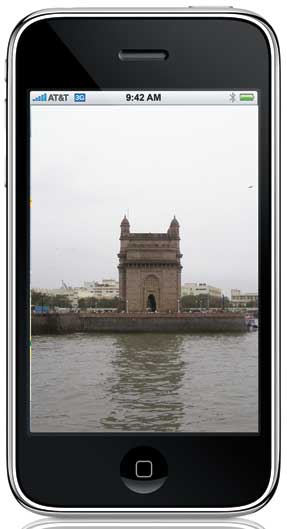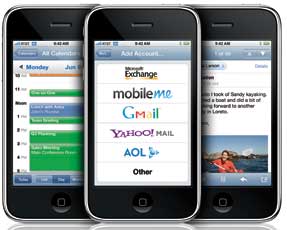Business
iPhone in India:
Has Apple Dialed the Wrong Number?
|
At midnight on August 22, Apple rolled out its iPhone in India and some 20 new countries. It didn’t roll too far. Some retail outlets of the two service providers Apple has linked up with – Vodafone and Bharti Airtel – discovered that they did not have the necessary permissions to stay open at that late hour. Others attracted a small number of curious consumers. But missing were the lines and fanfare that accompanied the iPhone’s launch in the U.S. and some other parts of the world. “Only a few buyers turned up at midnight launches done by both Airtel and Vodafone across eight cities in India,” The Economic Times reported. “At a Vodafone store in Connaught Place, Central Delhi, journalists outnumbered customers by a huge margin.”
One reason for the lack of excitement could be the almost total absence of any marketing. Newspapers reported the coming launch based on statements from Vodafone and Airtel: Apple was nowhere to be seen. The local Apple office in Bangalore – merely a sales and distribution set up – was “not authorized” to make any statements. “The build-up for the iPhone launch in India has been poor, if not pathetic,” says Harish Bijoor, brand specialist and CEO of Harish Bijoor Consults. “One of two things has happened. Either Apple believes the game has been lost in India even before it has begun, or it feels that the service providers will do magic with their mega-reach in India. There is a near abdication of ownership of the brand in the Indian market. The model at play seems to be outsourced marketing, outsourced branding and outsourced selling.” Skimming the Market Wharton marketing professor Peter Fader is inclined to believe that Apple may have a smarter strategy for its Indian iPhone launch than is immediately apparent. “If you compare (the iPhone’s) U.S. launch to the India launch, it is a beautiful example of the distinction between a ‘penetration strategy’ and a ‘skim strategy,'” he says. “Here in the U.S., Apple basically wanted to bust the market open all at once. So, they had all these people lined up all around the block, and when they flipped the switch – boom! – the market existed. In India, it’s almost like they are doing a test market.” In Fader’s view, Apple’s India strategy allows for much more flexibility. “A skim strategy is a great way of testing the waters so that you can change course, whereas with a penetration launch, whatever tactics you committed to, you’re stuck with – you can’t change them,” he says. “This way, they can change the price, change the messaging and broaden out to the larger market in a few years.” Apple doesn’t have a large installed base of Macintosh users in India, and that may also have persuaded it against a penetration launch for the iPhone, Fader notes. “If you don’t (have a significantly large base), you must go with a skim strategy, because you can’t create that market overnight.” Another albatross around the iPhone’s neck is its price. The 8GB version costs Rs. 31,000 ($710) while the 16GB iPhone is priced at Rs. 36,100 ($825). The corresponding prices in the U.S. are $199 and $299. “India is a price-sensitive market,” says Bijoor. “These levels are ridiculous.”
Bijoor believes that the iPhone will become a popular gadget, but that India’s tech consumers will likely “crack the (price) code” by purchasing it abroad at much cheaper rates and bringing it back to India. “If the iPhone is to increase its sales in India (beyond) sales for (officially imported or smuggled phones), it needs a price correction.” His prescription is drastic: Bring the price down to Rs. 12,000 ($275). Sunil Dutt, India country head for Samsung’s mobile division, thinks that will happen. “As for any new technology introduction, volumes are small in the initial phase. Once volumes grow, prices come down. I expect a similar trend.” Subsidized Handsets Why does the iPhone cost so much in India? The simple reason is that, unlike in the U.S. and other countries, the service providers are not subsidizing the handset. In the U.S., AT&T recovers the subsidy amount from subscribers during a contract “lock-in” period. The ARPU (average revenue per user) for AT&T is $50 plus. In India, Airtel has an ARPU of Rs. 357 ($8.16) and Vodafone’s is Rs. 350 ($7.99). These numbers don’t allow the luxury of subsidies. “The Indian cellular industry could never afford deep phone subsidies,” says Ravi Bapna, associate professor of information systems at the Carlson School of Management and executive director of CITNE at the Indian School of Business. Bapna believes that it’s not just the low ARPUs which work against possible cross-subsidization. “India’s open network/open application cell phone industry is (incompatible with) Apple’s strategy in the U.S., where it offers exclusivity to AT&T,” he says. “Lock-in is anathema for Indian consumers and, consequently, the purchase of the phone has never been linked to the purchase of the service.” AT&T reports that in the U.S., users of 3G (third generation) instruments such as the latest iPhone typically have ARPUs double those who use 2G devices. That won’t help in India, because the country doesn’t have a 3G network yet. “The iPhone 3G currently utilizes the EDGE network available in India,” says Mitra of Apple. But EDGE (Enhanced Data rates for GSM Evolution) is technologically a poor cousin of 3G, used in countries that haven’t yet made the transition.
Wharton marketing professor Jagmohan Raju believes the absence of a 3G network in India explains why Apple “seems to be targeting a very narrow segment of the market – one that uses the iPhone more as a status symbol.” Besides that, he says the “superior design and ease of use” of Apple’s products will bring in customers. “While a large majority of Indian consumers is price sensitive, there is a segment that is willing to pay for quality.” Fader says the lack of a 3G network in India will not be a real issue. “People are not buying (an iPhone) necessarily for its functional reasons; they are buying it to be seen at the club with it.” Consumers: Beyond the Basics With Apple not talking officially, and Airtel and Vodafone plowing their own furrows, there is little clarity on the numbers the iPhone has already achieved or expects to. More than 200,000 potential users pre-registered with Airtel and a similar number with Vodafone, but these figures are most likely inaccurate because registration could be done over the Internet and didn’t involve any commitment. Actual bookings had to be made by putting down $114 (for Airtel) and $228 (for Vodafone). According to estimates by The Economic Times, the real sales figures are more likely to be 5,000 per service provider. How many iPhones will sell? Optimists are looking at a full-year local sales figure of 500,000 – the same number of users analysts estimate BlackBerry has in India. India is now the third-largest smartphone market in the Asia-Pacific region, after Japan and China, says Canalys, a technology consultancy. India is the world’s fastest-growing mobile services market: In July, according to Telecom Regulatory Authority of India (TRAI) figures, it added a record 9.22 million subscribers in July to reach 296.08 million. These large numbers of users are increasingly moving beyond basics. “As the need of Indian mobile phone consumers is evolving, they are demanding feature-rich devices, which can cater to their business communication requirements as well as their personal needs,” says IDC. Meanwhile, Apple’s competitors are not relaxing. LG has unveiled the LG10000, a CDMA phone which will use the Reliance Communications network. This is already available in the U.S. as the Voyager. It will cost Rs. 22,000-25,000 in India. Philips has the Xenium in its product portfolio. Both are touchscreen, one of the iPhone’s principal attractions. Nokia, the market leader by far, preempted the iPhone in India with its N96, priced at around Rs. 36,000. The campaign for the N96 began on August 19, three days before the iPhone’s arrival. “We have unveiled the N96 in India and will be launching it in the market in early September,” says D. Shivakumar, Nokia India vice president and managing director. “It will be a global launch – in fact, all our products are rolled out in India at the same time as they are worldwide. What we have launched on (August) 19th is a pre-booking scheme, offering consumers the opportunity to secure the device early.” According to research firm Gartner, Nokia has a 45% share of the global smartphone market (as of the first quarter in 2008). RIM has 13.4%, with Apple just 5.3%. Rival Samsung has also thrown its hat into the ring with the Omnia. “It will be launched in India in September,” says Dutt. “Our new 2008 range of mobiles has been well received by customers. Our recently introduced TouchWiz has generated a lot of consumer interest, and I am confident that Omnia will do well here…. It is our all-in-one maxi phone.” Loans for Phones From a marketing perspective, there are other issues about which the iPhone launch has started a debate, such as whether people would be willing to take loans to purchase phones. Vodafone has tied up with Axis Bank and Barclays Bank to offer the iPhone to customers in six or 12 monthly installments. Will the strategy add sales? It depends, of course, on who the customers are. Bijoor has definite views on that. “The iPhone is the Gucci phone for the top end of the market,” such as C-suite inhabitants, he says. “In India, these are not the masses.” His conclusion: The people buying the iPhone can well afford to pay for it. Bapna of ISB says that although Apple may have lost its first battle, the war is only beginning. “Proven successes in the West do not necessarily replicate in emerging markets,” he says. |



